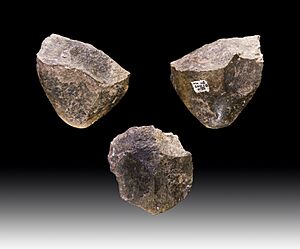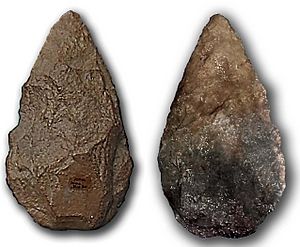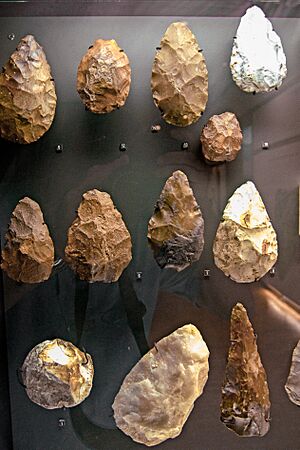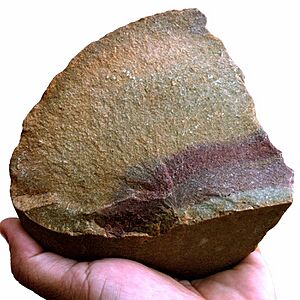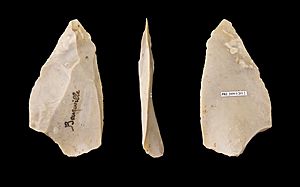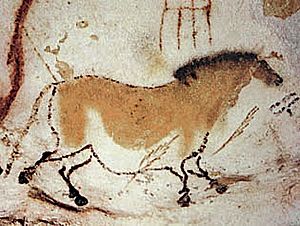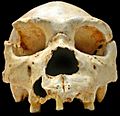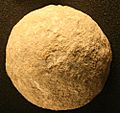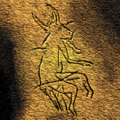Paleolithic facts for kids
The Paleolithic (say: Pay-lee-oh-LITH-ik) is a very long time in history when early humans made tools mostly from stone. It's also called the Old Stone Age. This period started about 3.3 million years ago in Africa and lasted until about 15,000 years ago. It was by far the longest part of human history, making up about 99% of it!
During the Paleolithic, not just our species, Homo sapiens, made tools. Other early human types like Homo habilis, Homo erectus, and Neanderthals also made them. These stone tools are the first cultural items that have survived for us to find today.
The Paleolithic Age ended when humans started making smaller, finer tools (this was the Mesolithic period) and later when they began farming (the Neolithic period). In some places, like Western Europe, the Ice age greatly affected how people lived.
During this time, humans lived in small groups. They survived by gathering plants and hunting wild animals. Besides stone tools, they also used tools made from wood and bone. They probably used leather and plant fibers too, but these materials usually don't last long enough to be found today.
Contents
Stone Tool Cultures
Early humans developed different ways of making stone tools over millions of years. Each way is called a "culture" or "industry" by archaeologists.
Oldowan Tools
The Oldowan tool-making style was used by early humans during the very beginning of the Paleolithic period. For a long time, people thought these were the first stone tools ever made, from 2.6 million years ago to 1.7 million years ago. We now know that stone tools were used even earlier, about 3.3 million years ago, before the Homo family even existed!
Oldowan tools were discovered by archaeologist Louis Leakey in the 1930s at a place called Olduvai Gorge in Tanzania. That's where the name "Oldowan" comes from.
We're not entirely sure which early human species first made Oldowan tools. They were widely used by early Homo species like Homo habilis. These tools are sometimes called pebble tools because they were made by chipping off pieces from rounded stones. They were used for chopping, scraping, and pounding.
Acheulean Tools
Acheulean tools were a more advanced type of stone tool made by early humans like Homo erectus. They started appearing about 1.8 million years ago, developing from the simpler Oldowan tools.
This tool-making style was used for a very long time and spread across Africa, Asia, and Europe. Acheulean tools are famous for their oval and pear-shaped hand axes. Some of these hand axes were made very carefully and beautifully.
The name "Acheulean" comes from Saint-Acheul, a place in France where some of the first examples were found in the 1800s.
Dating Acheulean Tools
Scientists use methods like potassium-argon dating to figure out how old these tools are. The earliest Acheulean tools found are about 1.65 million years old, from Kenya. In Europe, these tools arrived later, around 400,000 years ago.
It's important to remember that different tool-making styles sometimes existed at the same time. Acheulean tools were used alongside simpler tools like the Clactonian, and later, with more advanced tools like the Mousterian. Acheulean was a very successful way of making tools that was used across much of the world.
Clactonian Tools
The Clactonian is another style of flint tool making found in Europe, dating back about 400,000 years ago. These tools were made by Homo erectus. Similar simple tools from other regions are sometimes also called Clactonian.
The Clactonian style is named after tools found at Clacton-on-Sea in England in 1911. Along with the tools, remains of giant elephants and hippopotamuses were found.
Clactonian tools were made by hitting large, thick flakes off a core of flint. The core was then used as a chopper, and the flakes were used as simple knives or scrapers. Unlike the very first Oldowan tools, some Clactonian flakes had notches, which might mean they were attached to a handle.
Archaeologists found many Clactonian tools, but no hand axes, at a site where a Pleistocene elephant was butchered. This suggests that the people who used Clactonian tools might not have known how to make the more complex Acheulean hand axes, even if they had good flint available.
Mousterian Tools
The Mousterian tool-making style is linked to Neanderthals (Homo neanderthalensis). It dates from about 300,000 to 30,000 years ago. Mousterian tools were more varied than earlier tools, with up to thirty different types, compared to about six in the Acheulean.
The name "Mousterian" comes from Le Moustier, a rock shelter in France. Similar flint tools have been found across Europe, the Near East, and North Africa. This style includes hand axes, long blades, and points. These tools were much more finely made than any before them.
Neanderthals used a special method called the Levallois technique. This involved carefully preparing the stone core so that a long, thin, sharp blade could be struck off. To get such fine results, they likely used a "soft" hammer, perhaps made of deer antler, instead of a stone hammer. The larger brains of Neanderthals probably helped them make these advanced tools.
After the Mousterian, modern humans (Homo sapiens) started making even more specialized tools. In the Upper Paleolithic, there were at least 100 different types of tools, showing how our species developed many tools for specific tasks.
Paleolithic Timeline
The Paleolithic period is often divided into three parts, showing how technology and culture changed over time:
- Lower Paleolithic (about 2.6 or 2.5 million years ago to 100,000 years ago)
- Middle Paleolithic (about 300,000 to 30,000 years ago)
- Upper Paleolithic (about 45,000 or 40,000 to 10,000 years ago)
After the Paleolithic comes the Mesolithic and then the Neolithic eras, which mark the end of the Stone Age. The Bronze Age and Iron Age followed the Stone Age.
How Life Changed Through the Ages
| Age | Period | Tools | How People Lived (Economy) | Where People Lived | Society | Beliefs |
|---|---|---|---|---|---|---|
| Stone Age | Paleolithic | Sharpened flint or stone tools: hand axes, scrapers, wooden spears | Hunting and gathering (finding food in nature) | Moving around – caves, simple huts, shelters made of teeth or skin, often near rivers and lakes | Tribes of plant gatherers and hunters (25-100 people) | We see signs of beliefs in an afterlife in the Upper Paleolithic: people started burial rituals and ancestor worship. |
| Mesolithic (also called Epipaleolithic in warm places) | Small, fine tools: bow and arrow, harpoons, fish-baskets, boats | Tribes and Bands (small groups) | ||||
| Neolithic | Tools for farming: chisel, hoe, plough, reaping-hook, tools for grain, loom, pottery and weapons | Agriculture, Hunting and gathering, fishing and domestication of animals | Farmsteads during the Neolithic and Bronze Age. Cities started to form during the Bronze Age. | Tribes and chiefdoms (groups led by a chief) in some Neolithic societies. States and civilizations during the Bronze Age. | ||
| Bronze Age | Writing; tools made of copper and bronze, potter's wheel | Agriculture; raising cattle; crafts, trade | ||||
| Iron Age | Iron tools | |||||
Venus Figurines
Some of the earliest art we've found are called Venus figurines. These are very small statues of women, often shown as pregnant. They have been found from Western Europe all the way to Siberia. Most of them are between 20,000 and 30,000 years old.
Two figurines are much older: the Venus of Tan-Tan from Morocco (300,000 to 500,000 years old) and the Venus of Berekhat Ram from the Golan Heights (200,000 to 300,000 years old). These might be some of the very first objects showing the human form.
These figurines were made from different kinds of stone, bones, and ivory. Some were even made from clay and then baked in a fire, which is one of the earliest signs of using ceramics.
We don't know for sure what these figurines meant to the people who made them. Here are two main ideas:
- They might represent human fertility, or they might have been made to help with fertility.
- They might represent goddesses of fertility.
Scientists know they weren't linked to the fertility of farm fields, because agriculture hadn't been invented yet when most of these figurines were made.
Cave Paintings
Cave paintings are pictures drawn on the walls or ceilings of caves. Many famous cave paintings are from the Paleolithic Age, dating from about 15,000 to 30,000 years ago. Some of the most well-known are in the caves of Altamira in Spain and Lascaux in France. There are about 350 caves in Europe with these paintings.
Usually, animals like aurochs (ancient cattle), bisons, or horses were painted. We don't know why these paintings were made. They weren't just decorations for homes, because the caves where they are found usually don't show signs that people lived there.
One of the oldest painted caves is Chauvet Cave in France. Some paintings there are dated to around 30,000 to 33,000 years ago, and others to 26,000 or 27,000 years ago.
Paleolithic artists were very skilled. They understood perspective and different ways to draw. They also carefully watched the animals they painted, and some paintings show how the animals behaved. These paintings might have been important for rituals or ceremonies.
Diet and Nutrition

Paleolithic hunter-gatherers ate leafy vegetables, fruit, nuts, insects, meat, fish, and shellfish. It's hard to know exactly how much plant food versus animal food they ate because there isn't much direct evidence.
The idea of a single "Paleolithic diet" is tricky because the Paleolithic was such a long time, and people lived in many different places. For example, early humans probably didn't control fire until the Middle Paleolithic, and they didn't have tools for extensive fishing until later. Also, humans spread out from Africa to places like New Guinea and Alaska, so their diets had to change based on what was available locally.
Scientists have different ideas about how much plant and animal food people ate. Just like modern hunter-gatherers, there were many different "diets" depending on the group and region. In colder areas, people needed more meat. Many modern hunting tools, like fish hooks and bows, only appeared in the Upper Paleolithic. Before that, people mainly used hand-held spears and harpoons.
Some experts believe that until the Upper Paleolithic, humans mainly ate fruit, and added carrion (dead animals), eggs, and small prey like baby birds and mussels. They might have only rarely managed to kill large animals like antelopes. This idea is supported by studying chimpanzees, who are genetically very close to humans. Chimpanzees mostly eat plants (about 95%), with a small amount of insects, eggs, and baby animals.
Paleolithic people likely suffered less from famine and malnutrition than the farming groups who came after them. This is because hunter-gatherers had access to a wider variety of natural foods, which gave them a more nutritious diet and reduced the risk of starvation. Farmers often relied on just a few crops, which could lead to problems if those crops failed.
It's also thought that Paleolithic hunter-gatherers probably didn't get modern "diseases of wealth" like Type 2 diabetes or heart disease. This is because they ate mostly lean meats and plants, were very physically active, and didn't live as long as people do today.
Evidence shows that Paleolithic societies gathered wild grains for food at least 30,000 years ago. However, seeds like grains and beans were probably not eaten in large amounts every day. There's also evidence that winemaking might have started in the Paleolithic, with early humans drinking juice from naturally fermented wild grapes.
Paleolithic humans ate animal organ meats, including livers, kidneys, and brains. Late Upper Paleolithic groups might have even practiced very basic forms of horticulture (gardening) and animal husbandry (raising animals). For example, some European groups raised reindeer as early as 14,000 years ago, probably for meat or milk.
People during the Middle Paleolithic, like Neanderthals, started eating shellfish. Shellfish cooking has been found at Neanderthal sites in Italy from about 110,000 years ago. Although fishing became common later, fish were part of human diets much earlier. For example, Middle Paleolithic humans in the Democratic Republic of the Congo hunted large catfish with special barbed fishing tools as early as 90,000 years ago. The invention of fishing allowed some Upper Paleolithic groups to settle down in one place or move less often, which changed their social structures.
Related pages
Images for kids
-
An artist's drawing of a temporary wood house, based on findings at Terra Amata in Nice, France, from 400,000 years ago.
-
This skull of Homo heidelbergensis, an early human type from the Lower Paleolithic, is between 500,000 and 400,000 years old.
-
Many large mammals like woolly mammoths, woolly rhinoceroses, and cave lions lived during the Ice Age.
-
Stone ball from a set of Paleolithic bolas, used for hunting.
-
Bradshaw rock paintings found in the north-west Kimberley region of Western Australia.
-
Picture of a half-human, half-animal being in a Paleolithic cave painting in Dordogne, France. This might show early shamanic practices.
See also
 In Spanish: Paleolítico para niños
In Spanish: Paleolítico para niños


